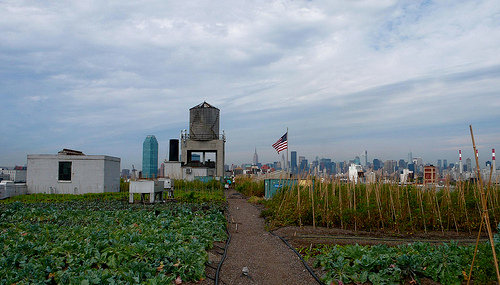November 28, 2011


If predictions are correct that climate change and rising sea levels will create greater numbers of urban dwellers, the need for greater local food resources will be critical. Back in World War II, a large percentage of Americans had gardens to help supplement their food. This tradition, which continues today, has spread to the middle of some of our largest urban areas.
[nggallery id=62 template=carousel images=4]
[imagebrowser id=62]
By Debra Atlas
If predictions are correct that climate change and rising sea levels will create greater numbers of urban dwellers, the need for greater local food resources will be critical.
Back in World War II, a large percentage of Americans had gardens to help supplement their food. This tradition, which continues today, has spread to the middle of some of our largest urban areas. Volunteers work to transform what many times were vacant lots full of crumbling concrete or overgrown weeds into thriving, colorful, sustainable, agricultural landscapes.
These small farms share common themes:
Urban farms come in all shapes, sizes, and locales. More than 800 urban farms are spread throughout the United States and abroad, in places such as Newark, New Jersey; Chicago; Detroit; St. Louis; Denver; Boston; and Los Angeles. Here are a few stellar urban farms:
One of the more unusual urban farms is the 2011 World Challenge finalist, Brooklyn Grange Rooftop Farm. Set atop a six-story warehouse in Long Island City, Queens (New York), this 40,000-square-foot farm (almost 1.25 acres) is thought to be the largest rooftop garden in the world. Started in 2010 by four entrepreneurs, the farm grows and sells organic produce to restaurants and delis across Manhattan. They have proven so successful that a second site is being constructed to meet the demand for organic veggies, eggs, and honey. According to co-founder and head farmer Ben Flanner, they have created a model that can be reproduced on other rooftops around the country.
Another model urban farm is Alemany Farm in the southeast part of San Francisco—a decades-old,4.5-acre, organic farm run by volunteers. Growing produce such as tomatoes, peppers, ground cherries, and basil, they promote “ecological-economic development.”
Known as the Motor City, Detroit plans to expand its reputation agriculturally. Incorporating more than 70 acres of underutilized vacant lands and abandoned properties on Detroit’s lower east side, Hantz Farms intends to create the largest urban farm and sell sustainably grown fruits and vegetables.
Another urban farming project embodies community involvement. The Homeless Garden Project in Santa Cruz, California, cultivates organic produce and flowers while providing homeless men and women and those close to being homeless with job training and transitional services. They teach basic life skills and the principles of economic and ecological sustainability. The Project provides organic fruit, vegetables and flowers for the community through its Community Supported Agriculture (CSA) program.
These urban farms bring together adults, kids, musicians, artists, and corporations who are committed to creating unique and viable farms for the community, and bringing color and excitement to the urban landscape. These farms are helping to reduce carbon emissions and are providing opportunities and job skills that are helping to train a new generation of farmers in our cities.
Check out more articles by Debra Atlas.
© 2011 SCGH, LLC.
]]>